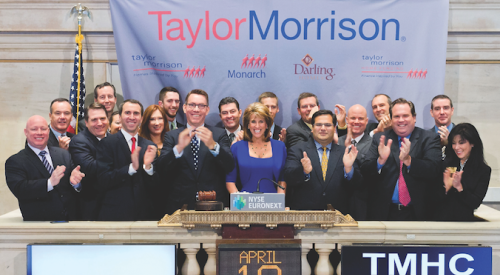|
Heather McCune, Editor in Chief
|
The data in our annual GIANTS issue overwhelm the senses. Chart after chart, table upon table, and more metrics to measure your business’ performance than you can find anywhere else. Digging in requires courage; passing it by risks much more.
Easing into it, start at the top line. Non-GIANTS accounted for 65.3% of total U.S. housing completions in 2003, down 2.5% from 2002. Most interesting is how market share split within the GIANT 400. Masters of the Universe, GIANTS 1-20, captured 16.7% of the pie, up 1.7% from the previous year. The Rich and Famous, builders 21-125, upped their share slightly, from 10.0% to 10.8%. Holding their own were the Achievers, builders 126-275, and the Strivers, 276-400, at 4.7% and 2.4%, respectively, exactly the same as in 2002.
Other pertinent facts about the 2004 GIANT 400:
- GIANTS’ housing revenue was up 18.5%, and closings rose 9.7%.
- The list includes 50 builders that were not GIANTS last year.
- Approximately 15 of the 2003 GIANTS were dropped because of acquisitions.
- The 400th GIANT in terms of closings built 179 units, up 67 from five years ago.
- No. 113 Young Homes (Rancho Cucamonga, Calif.) moved up more than any other firm that was ranked last year, rising 168 places.
Digging deeper, real differences emerge in year-over-year data. Most noticeable: a 62.09% jump in high-rise units built by GIANTS, with a corresponding 33.5% revenue increase. What’s fueling this surge? Just about everything.
Municipalities concerned about sprawl are legislating builders back into cities, where a project goes up because there isn’t the land to go out. Changing buyer demographics make new home options in urban environments more salable than ever. In analyzing sales activity by life stage, John Burns found that married couples younger than 55 and without children — prime urban buyers — purchase more new homes every year than young families do. In addition, the greatest growth in new home sales in 2004 will come from empty nesters, retirees and mature families (youngest child is 6 or older).
Beyond the changing product and market mixes, the cost of doing business — and the opportunities to boost the bottom line — differ significantly among the four groups of GIANTS and between this year’s 400 and last year’s. While market expansion remains the greatest opportunity for the Masters, they expect better product marketing to yield greater profit as well, an interesting assumption in that marketing and advertising expenses account for just 2.31% of their average home price. Expansion in both markets and niches holds the greatest promise for top- and bottom-line growth for the remaining three groups. Add operational efficiencies to the list for Strivers, and a clear picture emerges:
The best bet for making the 2005 GIANT 400 means new products in new markets with new people for a changing customer base.
Making that bet pay off means that management, now more than ever, must manage the mix without getting mired in the day-to-day. The elements of the mix go beyond product, price point and piece of ground. As the business of building becomes more complex and competitive, ask yourself these questions:
- Does our organization have the right talent mix?
- Do we have the market and buyer data to deliver a product that warrants a premium price?
- Do we know what factors influence buyer behaviors?
- Have we aligned with the right building products and trade partners to deliver the homes that buyers expect?
To get a better outcome, it isn’t enough to do tomorrow what you did yesterday.












